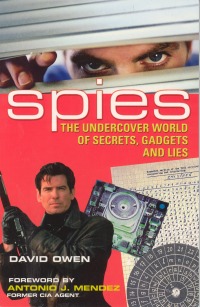| ________________
CM . . .
. Volume XI Number 15 . . . .April 1, 2005
excerpt:
As its title indicates, Spies deals with the shadowy world of espionage. It is filled with tales of spying from ancient Greece to the 21st century. It explains why nations spy on each other, gives many examples of spies and how they carry out their tasks and explains how spying has helped achieve victory in war time. The very nature of espionage and the activities of those engaged in it make Spies an exciting book to read. The Forward, written by former Central Intelligence Agency officer Antonio J. Mendez, gives the book an added sense of excitement. The book is divided into nine short chapters dealing with different aspects of espionage such as codes, electronic spying, deception and the use of satellites. It is very up-to-date with information on Osama bin Laden and international terrorism, subjects dealt with frequently in the media. Spies could be used as a text or for recreational reading, and it is written in a style suitable for the intended audience. Young readers with vivid imaginations, and older readers too, should enjoy it. Included in the chapters are 24 Case Studies, usually two pages in length, of specific espionage events such as the Cuban Missile Crisis of 1962 and of famous spies such as the Russian, Colonel Oleg Penkovsky. There is even one of fictional spy, James Bond, and his tools of spy craft. These studies could form the basis for class presentations. A notable weakness, in an otherwise flawless book, is the omission of the "Cambridge Spy Ring" of Kim Philby, Guy Burgess, Donald Maclean and Anthony Blunt. Recruited by the Soviets in the 1930s while at university, these members of the establishment passed on numerous secrets to their Soviet handlers and did incalculable harm to Britain. While traitors to Britain, they were masters of espionage and should have been included before the fictional Bond. Spies contains many fascinating facts. One deals with the use of Navajo speaking soldiers by the Americans during the Second World War to send messages to their forces in the Pacific. Even if intercepted by the Japanese, they had no idea what the messages meant. None of them understood Navajo. In the same way, the British used Welsh speakers to confuse the enemy during the recent war in Bosnia. In addition to stories of spying, Spies recounts numerous successful efforts to confuse enemies using lies and misinformation. This may be done using captured enemy spies to pass lies on as the truth or by outright deception. The latter method was used to great advantage by the Allies during the Second World War. One example involved American General George Patton, an officer feared by the Germans because of his aggressive tactics. To confuse the Germans about allied plans for the invasion of Normandy, Patton was put in charge of a fictitious army in the south east of England. Armed with dummy tanks, guns and airplanes, this fake army, which was photographed by enemy planes, convinced the Germans that the Allies would invade France from the southeast and not from where the invasion eventually took place. As a result, fewer troops were waiting when the allies invaded from a departure point further to the west. Spies is profusely illustrated throughout with both black and white and coloured photographs. These are functional and coincide with the message in the text, thereby adding greatly to the book's value. The book also contains an index and a glossary, useful for handy reference. Author, David Owen, is a man of many talents. An engineer, he produces TV documentaries and has written several other books including Final Frontier and Police Lab. Highly Recommended. Thomas F. Chambers is a retired college teacher living in North Bay, ON.
To comment
on this title or this review, send mail to cm@umanitoba.ca.
Copyright © the Manitoba Library Association. Reproduction for personal
use is permitted only if this copyright notice is maintained. Any
other reproduction is prohibited without permission.
NEXT REVIEW |
TABLE OF CONTENTS FOR THIS ISSUE
- April 1, 2005.
AUTHORS |
TITLES |
MEDIA REVIEWS |
PROFILES |
BACK ISSUES |
SEARCH |
CMARCHIVE |
HOME |
